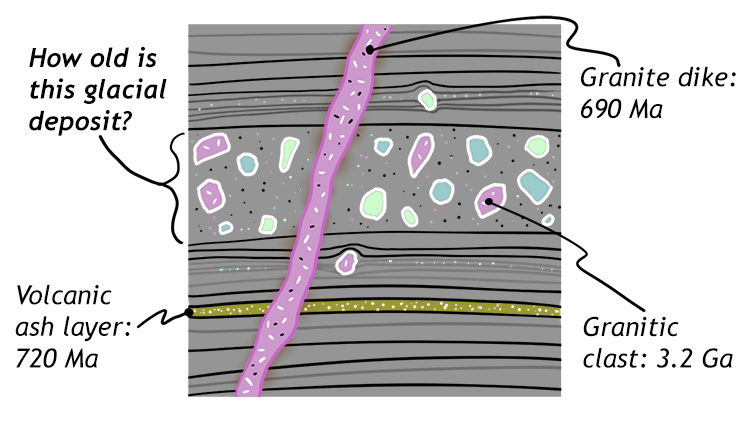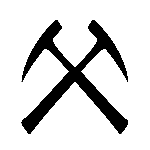20.6: When were the Snowballs?
- Page ID
- 22763
\( \newcommand{\vecs}[1]{\overset { \scriptstyle \rightharpoonup} {\mathbf{#1}} } \)
\( \newcommand{\vecd}[1]{\overset{-\!-\!\rightharpoonup}{\vphantom{a}\smash {#1}}} \)
\( \newcommand{\id}{\mathrm{id}}\) \( \newcommand{\Span}{\mathrm{span}}\)
( \newcommand{\kernel}{\mathrm{null}\,}\) \( \newcommand{\range}{\mathrm{range}\,}\)
\( \newcommand{\RealPart}{\mathrm{Re}}\) \( \newcommand{\ImaginaryPart}{\mathrm{Im}}\)
\( \newcommand{\Argument}{\mathrm{Arg}}\) \( \newcommand{\norm}[1]{\| #1 \|}\)
\( \newcommand{\inner}[2]{\langle #1, #2 \rangle}\)
\( \newcommand{\Span}{\mathrm{span}}\)
\( \newcommand{\id}{\mathrm{id}}\)
\( \newcommand{\Span}{\mathrm{span}}\)
\( \newcommand{\kernel}{\mathrm{null}\,}\)
\( \newcommand{\range}{\mathrm{range}\,}\)
\( \newcommand{\RealPart}{\mathrm{Re}}\)
\( \newcommand{\ImaginaryPart}{\mathrm{Im}}\)
\( \newcommand{\Argument}{\mathrm{Arg}}\)
\( \newcommand{\norm}[1]{\| #1 \|}\)
\( \newcommand{\inner}[2]{\langle #1, #2 \rangle}\)
\( \newcommand{\Span}{\mathrm{span}}\) \( \newcommand{\AA}{\unicode[.8,0]{x212B}}\)
\( \newcommand{\vectorA}[1]{\vec{#1}} % arrow\)
\( \newcommand{\vectorAt}[1]{\vec{\text{#1}}} % arrow\)
\( \newcommand{\vectorB}[1]{\overset { \scriptstyle \rightharpoonup} {\mathbf{#1}} } \)
\( \newcommand{\vectorC}[1]{\textbf{#1}} \)
\( \newcommand{\vectorD}[1]{\overrightarrow{#1}} \)
\( \newcommand{\vectorDt}[1]{\overrightarrow{\text{#1}}} \)
\( \newcommand{\vectE}[1]{\overset{-\!-\!\rightharpoonup}{\vphantom{a}\smash{\mathbf {#1}}}} \)
\( \newcommand{\vecs}[1]{\overset { \scriptstyle \rightharpoonup} {\mathbf{#1}} } \)
\( \newcommand{\vecd}[1]{\overset{-\!-\!\rightharpoonup}{\vphantom{a}\smash {#1}}} \)
\(\newcommand{\avec}{\mathbf a}\) \(\newcommand{\bvec}{\mathbf b}\) \(\newcommand{\cvec}{\mathbf c}\) \(\newcommand{\dvec}{\mathbf d}\) \(\newcommand{\dtil}{\widetilde{\mathbf d}}\) \(\newcommand{\evec}{\mathbf e}\) \(\newcommand{\fvec}{\mathbf f}\) \(\newcommand{\nvec}{\mathbf n}\) \(\newcommand{\pvec}{\mathbf p}\) \(\newcommand{\qvec}{\mathbf q}\) \(\newcommand{\svec}{\mathbf s}\) \(\newcommand{\tvec}{\mathbf t}\) \(\newcommand{\uvec}{\mathbf u}\) \(\newcommand{\vvec}{\mathbf v}\) \(\newcommand{\wvec}{\mathbf w}\) \(\newcommand{\xvec}{\mathbf x}\) \(\newcommand{\yvec}{\mathbf y}\) \(\newcommand{\zvec}{\mathbf z}\) \(\newcommand{\rvec}{\mathbf r}\) \(\newcommand{\mvec}{\mathbf m}\) \(\newcommand{\zerovec}{\mathbf 0}\) \(\newcommand{\onevec}{\mathbf 1}\) \(\newcommand{\real}{\mathbb R}\) \(\newcommand{\twovec}[2]{\left[\begin{array}{r}#1 \\ #2 \end{array}\right]}\) \(\newcommand{\ctwovec}[2]{\left[\begin{array}{c}#1 \\ #2 \end{array}\right]}\) \(\newcommand{\threevec}[3]{\left[\begin{array}{r}#1 \\ #2 \\ #3 \end{array}\right]}\) \(\newcommand{\cthreevec}[3]{\left[\begin{array}{c}#1 \\ #2 \\ #3 \end{array}\right]}\) \(\newcommand{\fourvec}[4]{\left[\begin{array}{r}#1 \\ #2 \\ #3 \\ #4 \end{array}\right]}\) \(\newcommand{\cfourvec}[4]{\left[\begin{array}{c}#1 \\ #2 \\ #3 \\ #4 \end{array}\right]}\) \(\newcommand{\fivevec}[5]{\left[\begin{array}{r}#1 \\ #2 \\ #3 \\ #4 \\ #5 \\ \end{array}\right]}\) \(\newcommand{\cfivevec}[5]{\left[\begin{array}{c}#1 \\ #2 \\ #3 \\ #4 \\ #5 \\ \end{array}\right]}\) \(\newcommand{\mattwo}[4]{\left[\begin{array}{rr}#1 \amp #2 \\ #3 \amp #4 \\ \end{array}\right]}\) \(\newcommand{\laspan}[1]{\text{Span}\{#1\}}\) \(\newcommand{\bcal}{\cal B}\) \(\newcommand{\ccal}{\cal C}\) \(\newcommand{\scal}{\cal S}\) \(\newcommand{\wcal}{\cal W}\) \(\newcommand{\ecal}{\cal E}\) \(\newcommand{\coords}[2]{\left\{#1\right\}_{#2}}\) \(\newcommand{\gray}[1]{\color{gray}{#1}}\) \(\newcommand{\lgray}[1]{\color{lightgray}{#1}}\) \(\newcommand{\rank}{\operatorname{rank}}\) \(\newcommand{\row}{\text{Row}}\) \(\newcommand{\col}{\text{Col}}\) \(\renewcommand{\row}{\text{Row}}\) \(\newcommand{\nul}{\text{Nul}}\) \(\newcommand{\var}{\text{Var}}\) \(\newcommand{\corr}{\text{corr}}\) \(\newcommand{\len}[1]{\left|#1\right|}\) \(\newcommand{\bbar}{\overline{\bvec}}\) \(\newcommand{\bhat}{\widehat{\bvec}}\) \(\newcommand{\bperp}{\bvec^\perp}\) \(\newcommand{\xhat}{\widehat{\xvec}}\) \(\newcommand{\vhat}{\widehat{\vvec}}\) \(\newcommand{\uhat}{\widehat{\uvec}}\) \(\newcommand{\what}{\widehat{\wvec}}\) \(\newcommand{\Sighat}{\widehat{\Sigma}}\) \(\newcommand{\lt}{<}\) \(\newcommand{\gt}{>}\) \(\newcommand{\amp}{&}\) \(\definecolor{fillinmathshade}{gray}{0.9}\)We have already mentioned that when most geoscientists talk about the “Snowball Earth,” they mean the glaciations that occured during the Cryogenian period of the Neoproterozoic era, specifically the Sturtian and the Marioan glaciations. The Sturtian occurred approximately 720 to 710 Ma, and the Marinoan around 660 to 635 Ma. Both the Sturtian and Marinoan glaciations show a global distribution of their sedimentary deposits. Their ages are not determined by fossils, but by relationships with rock units that are datable using isotopic methods (ash deposits, cross-cutting dikes, inclusions of datable rocks etc.).
Consider this hypothetical demonstration of the relevant information:

These techniques are nothing special for Snowball Earth only, but merely the application of general relative dating principles to the question of the timing of Neoproterozoic glaciation.
Some scientists also consider the slightly younger Gaskiers glacation (635 to 542 Ma, during the Ediacaran period of the Neoproterozoic) as a “Snowball Earth” glaciation. However, the paleomagnetic signatures on Gaskiers deposits are relatively high-latitude, not tropical or equatorial. There are also a lot fewer sites that host Gaskiers-aged strata, though it is recorded from at least eight small paleocontinental landmasses. (This is in contrast to dozens apiece for the Sturtian and Marinoan.) Considering the Gaskiers is younger than the Marinoan and Sturtian, and therefore less likely to have been destroyed by subsequent rock cycle processes, this implies it was truly not as extensive in distribution. Furthermore the Gaskiers glaciation has no known associated banded iron formations, suggesting that ocean water continued to exchange oxygen with the atmosphere during glaciation, and therefore no global sheath of sea ice existed then. Finally, dating of volcanic ash deposits to constrain the age of the Gaskiers glaciation suggest that the entire ice age lasted for only about 340,000 years, which is inconsistent with the multi-million year expectation based on the “Snowball Cycle.”


If we go back in time, to the Paleoproterozoic era, we find that there was another episode of glaciation recorded, though whether it was also a true “Snowball” (in the sense of ice reaching all the way to the equator) is a difficult question to answer. It is sometimes called the Huronian glaciation or Makganyene glaciation. It dates to between 2.4 and 2.1 Ga, and is best preserved in North America in Ontario’s Gowganda Formation, a striking jet-black tillite that formed about 2.3 Ga.
(Being positioned in southern Ontario meant that the Gowganda’s glacial deposits were ideally positioned for plucking by Pleistocene ice age glaciers. This means that in some very young glacial deposits, we can find pieces of very old glacial deposits!)
Did I Get It? - Quiz
Which of the following "Snowball Earth" glaciations happened from 660 Ma to 635 Ma?
a. Marinoan
b. Sturtian
c. Ediacaran
d. Gaskiers
- Answer
-
a. Marinoan
What makes the Gaskiers glacation distinct from the Sturtian and Marinoan glaciations?
a. It is characterized by exceptionally mature deposits of quartz sand, well-rounded pebbles, and rock salt deposits.
b. It shows a more limited extent, has no banded iron formations, and is the youngest of the three.
c. It is the only "Snowball Earth" glaciation to occur in the Phanerozoic eon.
d. It shows a more extensive distribution of deposits, has the largest amount of associated banded iron formations, and is the oldest of the three.
- Answer
-
b. It shows a more limited extent, has no banded iron formations, and is the youngest of the three.
As precisely as possible, how old is the glacial deposit illustrated in this cross-section?

a. Between 3.2 Ga and 720 Ma (and thus likely Marinoan).
b. Between 720 Ma and 690 Ma (and thus likely Sturtian).
c. Between 690 Ma and 330 Ma (and thus likely Gaskiers).
d. Between 3.2 Ga and 690 Ma (and thus likely Sturtian).
- Answer
-
b. Between 720 Ma and 690 Ma (and thus likely Sturtian).
Are there any records of glaciation on Earth prior to the Neoproterozoic Snowball Earths?
a. No
b. Yes
- Answer
-
b. Yes


